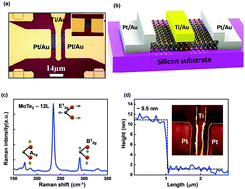Few-layered α-MoTe2 Schottky junction for a high sensitivity chemical-vapour sensor†
Abstract
For the first time, we connect in series two α-MoTe2-based Schottky diodes (SDs) to form a back-to-back diode using the micromechanical exfoliation method. The α-MoTe2 SD exhibits an excellent ON/OFF current ratio of ∼103 and low-voltage operation at 5 V. Although various studies of α-MoTe2 field-effect transistors (FETs), phototransistors, and p–n diodes have been reported, there are no reported theoretical or experimental studies of α-MoTe2 for chemical sensing. Here, we experimentally assess the SD and a FET for gas sensing with exposure to different concentrations of NO2 and NH3. Interestingly, the α-MoTe2 SD showed a faster response and recovery time to NH3 and NO2 than the α-MoTe2 FET owing to its Schottky junction, which is favorable for detecting the Schottky-barrier height change due to gas exposure. The SD showed a fast response of 15 s when exposed to 70-ppb NO2 and ∼1 s when exposed to 70 ppb NH3 with a relative resistance change of 13% and 101%, respectively, and this was attributed to its physisorption process. In addition, our results are confirmed by density functional theory. The α-MoTe2-based SD is shown to be promising as an electrical rectifier or as a gas sensor owing to its simple and inexpensive electrical circuitry and excellent performance, including its low voltage, high ON/OFF current ratio and good sensitivity to toxic gases at room temperature. Further, it may be suitable for diverse uses, such as chemical and biosensing applications.



 Please wait while we load your content...
Please wait while we load your content...